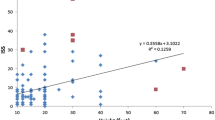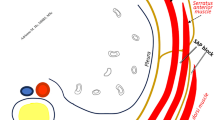Abstract
The purpose of the present study was to assess incidence, fracture type, and location of spine fractures due to falls. All emergency room CT requests during a time period of 26 months were reviewed retrospectively. Patients who had fallen or jumped and were initially examined with multidetector CT (MDCT) were included. The MDCT studies were evaluated by two radiologists for trauma location, fracture type, and multiple level involvement. A total of 237 patients (184 males, 53 female, age range 16–86 years, mean age 42 years) met the inclusion criteria. A total of 203 vertebral fractures were seen in 127 patients. Burst fracture (n=78) was the most frequent type of trauma, usually located in the thoracolumbar junction (50%). Also, compression fracture (n=52) was most common in the thoracolumbar junction (39%). Posterior column fracture (n=52) was most frequently detected in the cervical spine (40%). Multiple-level spine fractures were seen in 41 (32%) of the injured patients, of which 12 (29%) had fractures at noncontinuous levels. With increasing height the overall incidence of fractures increased, and burst fractures and multiple level spine fractures became more frequent. Age had no effect on fracture type or location. Spine fractures due to falls are common. Burst fracture is the most common fracture type and most frequently seen in the thoracolumbar junction. Multiple-level fractures were seen in 32% of the cases, of which 29% were seen at noncontinuous levels. Serious spine fractures are seen in all falling height and age groups.




Similar content being viewed by others
References
Harris JH Jr (2000) Spine, including soft tissues of the pharynx and neck. In: Harris JH Jr, Harris WH (eds) The radiology of emergency medicine. Lippincott Williams and Wilkins, Philadelphia, pp 137–298
Jelly LM, Evans DR, Easty MJ, Coats TJ, Chan O (2000) Radiography vs spiral CT in the evaluation of cervicothoracic junction injuries in polytrauma patients who have undergone intubation. Radiographics 20:251–259
Edwards MJ, Frankema SP, Kruit MC, Bode PJ, Breslau PJ, van Vugt AB (2001) Routine cervical spine radiography for trauma victims: Does everybody need it? J Trauma 50:529–534
Lali HS, Fehlings MG (2001) Epidemiology, demographics, and pathophysiology of acute spinal cord injury. Spine 26:2–12
Ghanta MK, Smith LM, Polin RS, Marr AB, Spires WV (2002) An analysis of eastern association for the surgery of trauma practice guidelines for cervical spine evaluation in a series of patients with multiple imaging techniques. Am Surg 68:563–568
Floyd T (2001) Alpine skiing, snowboarding, and spinal trauma. Arch Orthop Trauma Surg 121:433–436
Goldberg W, Mueller C, Panacek E, Tigges S, Hoffman JR, Mower WR (2001) Distribution and patterns of blunt traumatic cervical spine injury. Ann Emerg Med 38:17–21
Novelline RA, Rhea JT, Rao PM, Stuk JL (1999) Helical CT in emergency radiology. Radiology 213:321–339
Blackmore CC, Mann FA, Wilson AJ (2000) Helical CT in the primary trauma evaluation of the cervical spine: an evidence-based approach. Skeletal Radiol 29:632–639
Borock EC, Gabram SG, Jacobs LM, Murphy MA (1991) A prospective analysis of a two year experience using computed tomography as an adjunct for cervical spine clearance. J Trauma 31:1001–1005
Linsenmaier U et al. (2002) Whole-body computed tomography in polytrauma: techniques and management. Eur Radiol 12:1728–1740
Leidner B, Beckman MO (2001) Standardized whole-body computed tomography as screening tool in blunt multitrauma patients. Emerg Radiol 8:20–28
Rydberg J, Buckwalter KA, Caldemeyer KS et al. (2000) Multisection CT: scanning techniques and clinical applications. Radiographics 20:1787–1806
Kösling S, Dietrich K, Steinecke R, Klöppel R, Schulz HG (1997) Diagnostic value of 3D CT surface reconstruction in spinal fractures. Eur Radiol 7:61–64
Denis F (1984) Spinal instability as defined by the three-column spine concept in acute spinal trauma. Clin Orthop 189:65–76
Magerl F, Aebi M, Gertzbein SD, Harms J, Nazarian S (1994) A comprehensive classification of thoracic and lumbar injuries. Eur Spine J 3:184–201
Daffner RH, Daffner SD (2002) Vertebral injuries: detection and implications. Eur J Radiol 42:100–116
Allen BL Jr, Ferguson RL, Lehmann TL, O’Brien RP (1982) A mechanistic classification of closed, indirect fractures and dislocations of the lower cervical spine. Spine 7:1–27
Mann FA, Lomoschitz FM (2002) Improving the imaging diagnosis of cervical spine injury in the very elderly: implications from the epidemiology of injury. American Society Of Emergency Radiology (ASER) Scientific program, pp 80–83
Nunez DB et al. (1994) Clearing the cervical spine in multiple-trauma victims: a time-effective protocol using helical computed tomography. Emerg Radiol 1:273–278
Keenen TL, Antony J, Benson DR (1990) Non-contiguous spinal fractures. J Trauma 30:489–501
Author information
Authors and Affiliations
Corresponding author
Rights and permissions
About this article
Cite this article
Bensch, F.V., Kiuru, M.J., Koivikko, M.P. et al. Spine fractures in falling accidents: analysis of multidetector CT findings. Eur Radiol 14, 618–624 (2004). https://doi.org/10.1007/s00330-003-2090-6
Received:
Revised:
Accepted:
Published:
Issue Date:
DOI: https://doi.org/10.1007/s00330-003-2090-6




